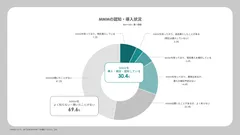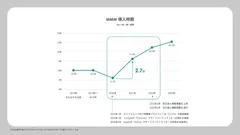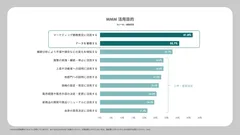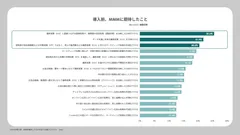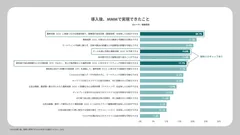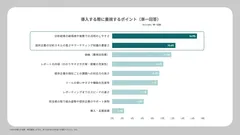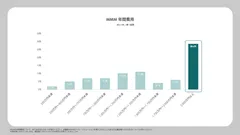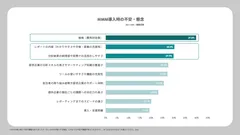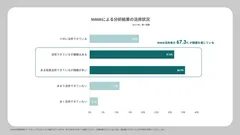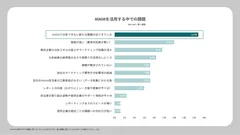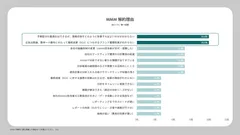XICA releases the results of its MMM (Marketing Mix Modeling) Market Survey, which reveals the actual usage of MMM (Marketing Mix Modeling) in Japan.
Growing Gap in Data Use in Marketing Industry
株式会社サイカ
XICA Corporation (Headquarters: Minato-ku, Tokyo; President & CEO: Yoshiaki Hirao; hereafter "XICA") conducted the "MMM Market Survey" with the aim of clarifying the actual use of MMM (Marketing Mix Modeling), a method for integrated marketing analysis, in Japan.
The survey results indicated that only about 30% of marketers are aware of MMM, but those companies that are actively using MMM understand its limitations and are exploring new options beyond MMM. On the other hand, given that approximately 70% of marketers are unaware of MMM, it can be inferred that the gap in data utilization between companies that are advanced in marketing and those that are not is widening. In measuring the effectiveness of marketing, "visualization of the effects of brand accumulation" and "clarification of areas for improvement in each measure" based on data are likely to become issues in the future.
The press release is also available on our website.
https://xica.net/action/marketing-mix-modeling/
Background of the survey
MMM (Marketing Mix Modeling) is one of the marketing analysis methods to practice data-driven marketing. It visualizes the impact of each measure on sales through an integrated analysis that includes not only online and offline marketing measures, but also external factors other than advertising, such as competition and weather. In the United States, an advanced marketing country, about 80% of marketers are aware of this method and about half of companies are practicing it (*1), but as of 2020, only about 10% of Japanese companies had adopted it (*2).
Given this background, XICA conducted the "MMM Market Survey" to learn the latest status of MMM usage in Japan.
Summary of Survey Results
1. only about 30% of marketers are aware of MMM. On the other hand, the number of MMM implementations has been on an upward trend since 2021, when it surged by approximately 2.7 times.
2. 41.8% of those who have MMM have implemented MMM for the purpose of "marketing strategy formulation"; of the "visualization of direct and indirect effects on final results" and "forecasting of final results" expected of MMM, challenges remain in achieving "forecasting of final results".
3. at the time of MMM implementation, the most important factors are "convincing analysis results and ease of use" and "high level of analytical technology and marketing knowledge of the provider company.
4. The annual cost of MMM is more than 20 million yen. Price is a bottleneck for implementation.
5. The new issues beyond the use of MMM are "visualization of the effects of brand accumulation" and "clarification of points to be improved in each measure.
Survey Results
1. Only about 30% of marketers are aware of MMM. On the other hand, the number of MMM implementations has been on an upward trend since 2021, when it surged by a factor of 2.7
a. As a pre-survey before conducting this survey, 125 marketers were asked about their awareness and implementation status of MMM, and it was found that only 30.4% responded that they "have implemented, know about, or are interested in" MMM. The number of respondents who responded that they "know about MMM and are interested in" MMM was about 30.4% of those who responded that they "know about MMM and are interested in" MMM.
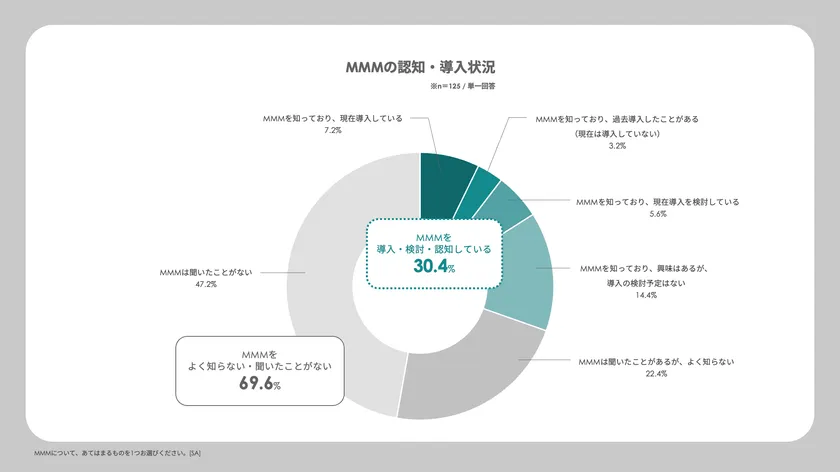
Status of MMM recognition and introduction
b. Next, when those who have introduced MMM were asked when they introduced MMM in this survey, 6.1% of respondents introduced MMM in 2020, while 16.3% introduced MMM in 2021, a 2.7-fold increase, suggesting that the number of MMM introductions surged in 2021. 2020 is the year that Google and Apple The number of MMM installations will continue to increase in 2022 and beyond, and although the MMM market itself is on an upward trend, the number of MMM installations is expected to continue to increase in 2022 and beyond, indicating that the market for MMM is expanding. The number of MMM introductions will continue to increase after 2022, indicating that the MMM market itself is on an expanding trend, but when looking at awareness and introduction status together, it is clear that MMM has not yet fully penetrated the marketing industry as a whole.
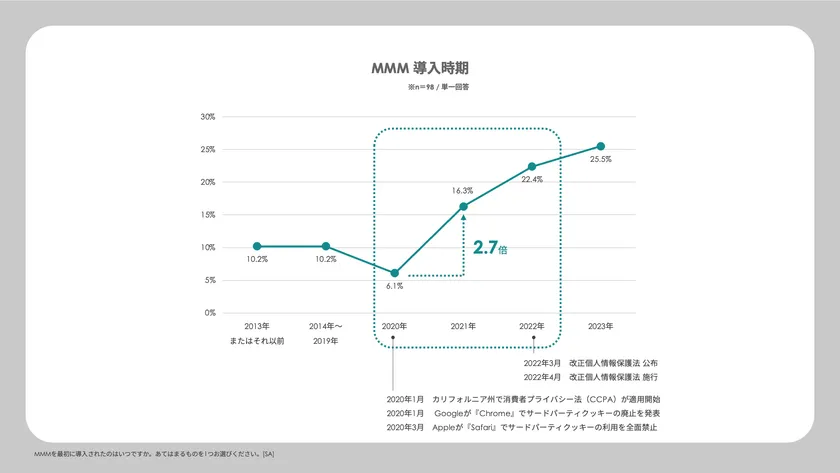
MMM introduction timing
2. 41.8% of those who have implemented MMM have implemented MMM for the purpose of "marketing strategy formulation"; of the two expected aspects of MMM, "visualization of direct and spillover effects (indirect effects) on final results" and "final results forecasting," challenges remain in achieving "final results forecasting.
a. We asked those who have implemented MMM about the purpose of MMM utilization. The top two responses were "To utilize for marketing strategy formulation (41.8%)" and "To accumulate data (35.7%)," indicating that MMM is used as a foundation for data utilization. On the other hand, less than 30% of the respondents use MMM for making decisions or making recommendations.
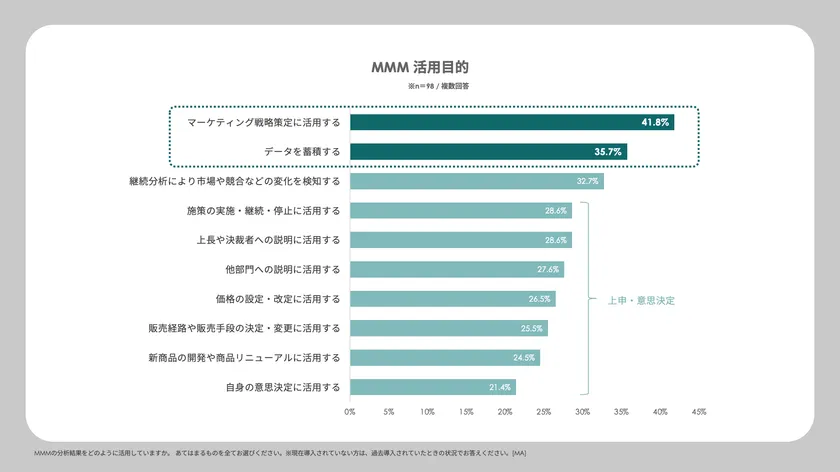
Purpose of MMM Use
b. We added the "interested" group to the respondents who have implemented MMM and asked them what they expected from MMM before implementation. top 3 responses were "Ability to analyze the direct and spillover effects (indirect effects) that directly lead to final results (KGI) (25.6%)," "Ability to predict future final results (KGI) based on data (21.9%)," "Ability to analyze the recognition and nomination (21.9%)," "Ability to analyze the data (21.9%)," and "Ability to analyze the data (21.9%). It is expected to be able to analyze not only the direct effects of measures but also the ripple effects (indirect effects), and to forecast final results with high accuracy. MMM is expected to provide highly accurate forecasts of final results.
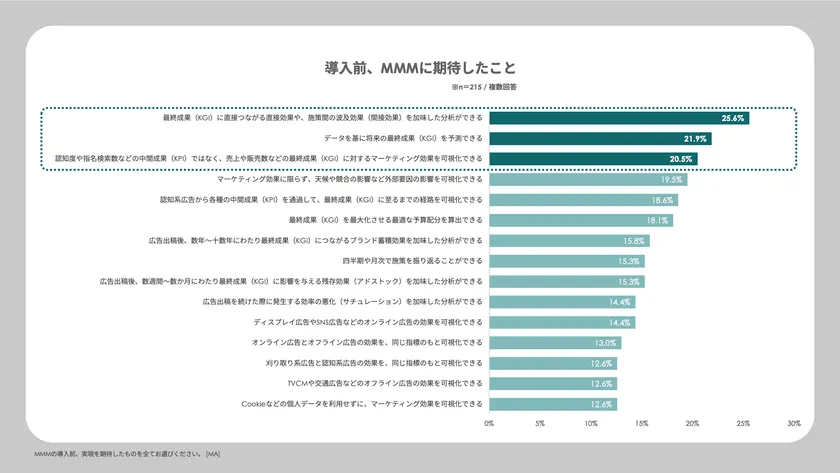
Expectations of MMM before its introduction
c. We also asked those who have implemented MMM what they have realized as a result of MMM implementation (*3). Compared to the "What I expected from MMM" above, "The ability to conduct analysis that takes into account direct effects and spillover effects (indirect effects) that directly lead to final results (KGI) (24.1%)" appears to have been realized to a certain extent. On the other hand, "Can predict future final results (KGI) based on data (19.0%)" and "Can visualize marketing effects on final results (KGI) such as sales and sales volume (17.7%) rather than intermediate results (KPI) such as awareness and number of nominated searches (17.7%)" showed some decline compared to expectations.
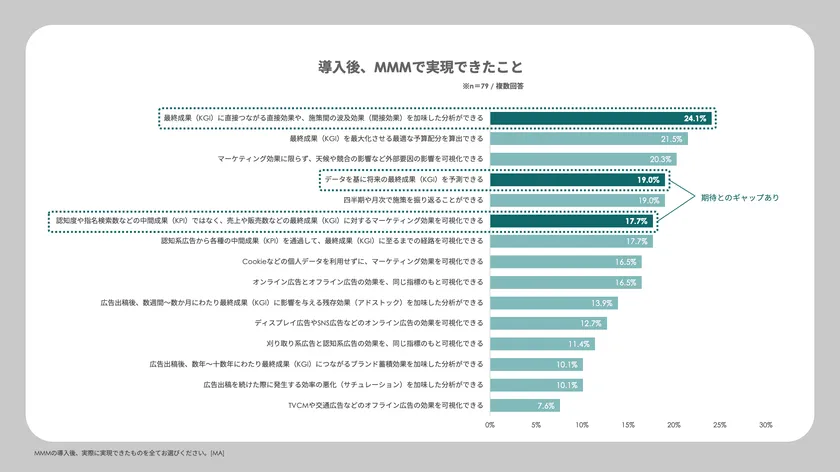
What MMM has made possible since its introduction
3. at the time of MMM implementation, the most important factors are "the sense of conviction and ease of use of the analysis results" and "the high level of analytical technology and marketing knowledge of the provider company.
a. When those who have implemented MMM were added to those who are interested in MMM and asked what they consider important when implementing MMM (*4), the TOP 2 were "Convincibility of analysis results and ease of use in practice (16.9%)" and "High level of skills and marketing knowledge of the provider company (12.6%)". It is clear that high analytical accuracy and easy-to-understand, convincing analysis that is in line with the reality of marketing activities are required.
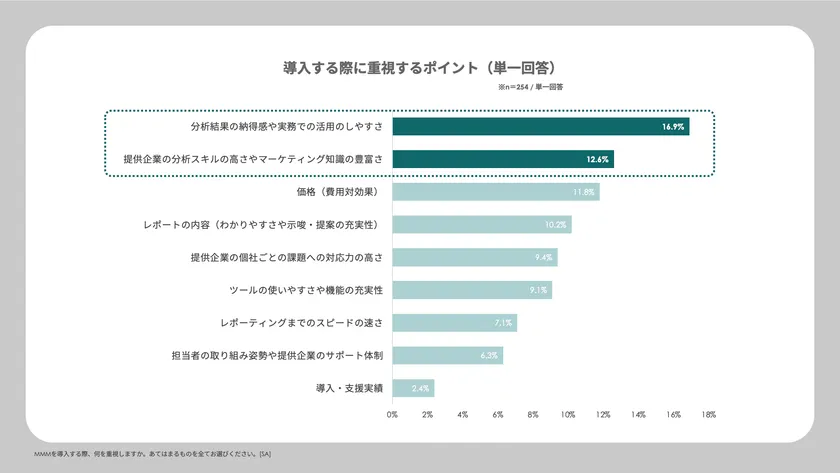
Points of Importance when Introducing MMM
4. The annual cost of MMM is over 20 million yen. Price is a bottleneck in implementation
a. When those with MMM implementation experience were asked about the annual cost of MMM, the most common response was "20 million or more.
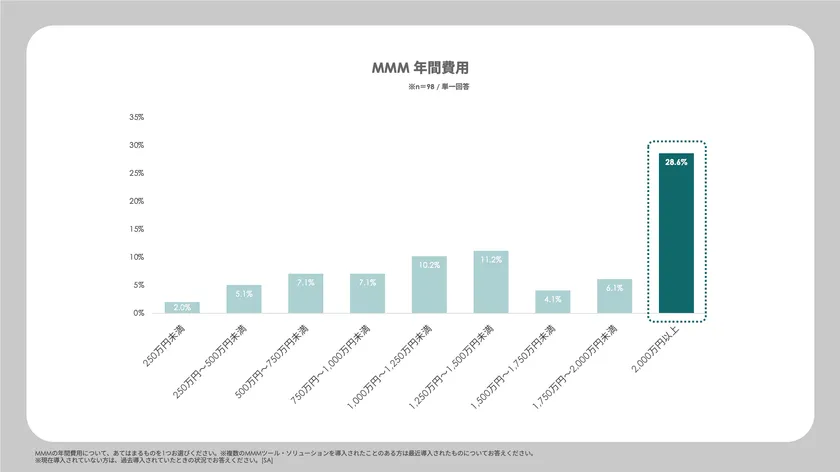
MMM annual cost
b. When those with MMM implementation experience plus those with interest in MMM were asked about their concerns when implementing MMM, the top response was "price (cost effectiveness)" (39.8%), indicating that price is the biggest bottleneck when implementing MMM. The second most common concerns were "report content (ease of understanding, suggestions and proposals) (30.3%)" and the third most common concerns were "convincing analysis results and ease of use in practice (29.9%)," indicating that respondents were anxious and concerned about understanding analysis results and incorporating them into measures.
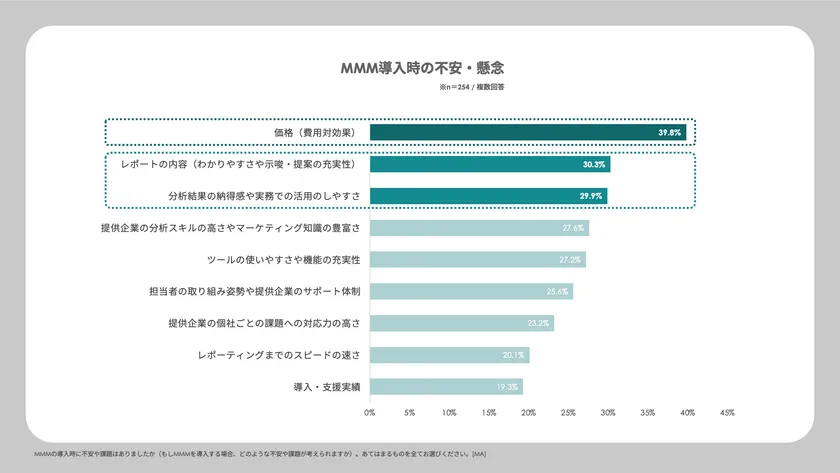
Concerns about MMM implementation
5. new challenges ahead of MMM implementation are "visualization of the effects of brand accumulation" and "clarification of areas for improvement for each measure
a. When those who have implemented MMM were asked how well they are utilizing MMM analysis results for marketing purposes, 67.3% responded "Yes, but there are issues (31.6%)" and "Yes, to some extent, but there are many issues (35.7%).
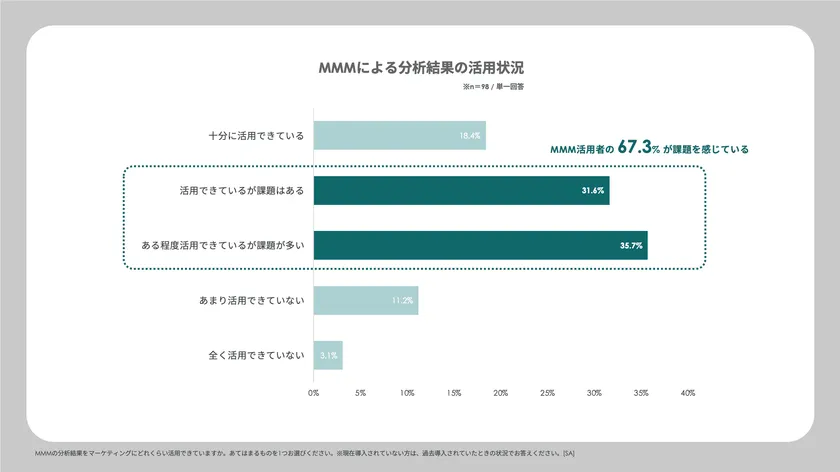
Status of utilization of analysis results by MMM
b. Furthermore, when we delved deeper into the sense of issues among those who are currently using MMM, "New issues that cannot be analyzed by MMM are emerging (16.9%)" was ranked first.
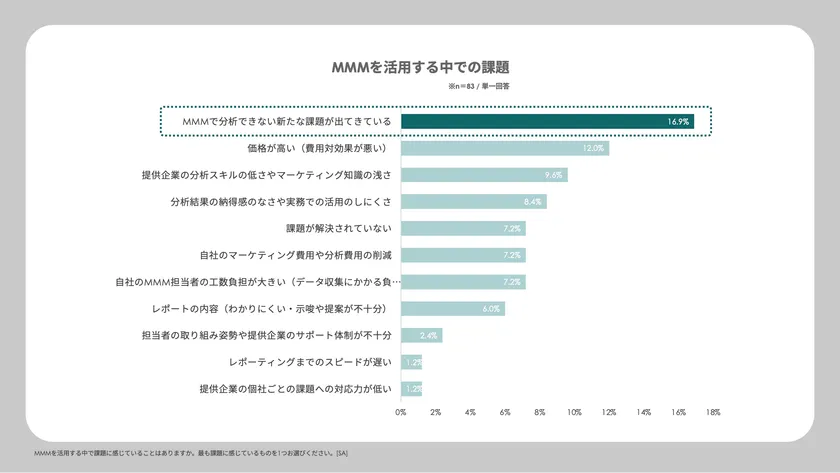
Challenges in utilizing MMM
c. When those who answered "New issues that cannot be analyzed by MMM are emerging" were asked about issues that cannot be solved by MMM, the most common responses were "Budget allocation can be optimized, but we don't know how to improve the measures themselves (20.0%)" and "We don't know the final results (KGI) for several years to a decade after placing an ad. The top two responses were "I don't know the effect of brand accumulation that will lead to final results (KGI) over several years to several decades after the advertisement is placed (20.0%). It is thought that new marketing challenges lie in the phase of incorporating the analysis results into specific measures and visualizing the brand accumulation effect.
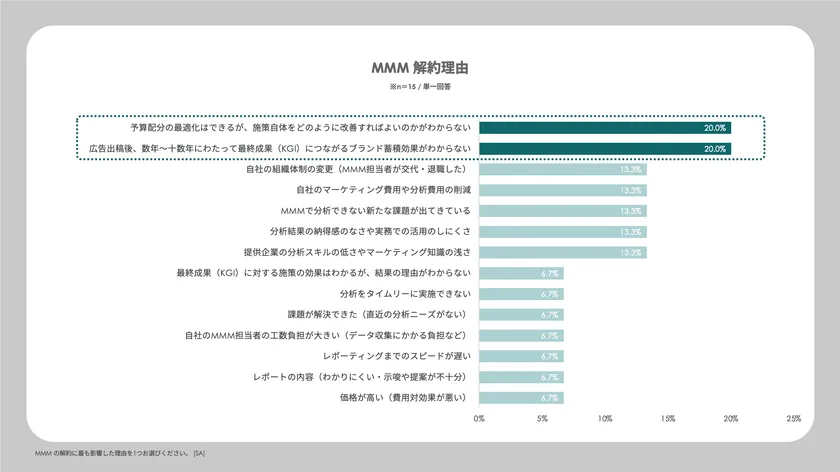
Reasons for MMM Cancellation
(*1) Publication of the latest consortium report by Nielsen Media, Facebook, and Google, "How to Improve Advertising Performance with Marketing Mix Modeling
(*2) Survey of 212 corporate advertising managers on how they measure the effectiveness of advertising, 2020 Edition (XICA Inc. press release) https://www.atpress.ne.jp/news/213842
(*3) The number of n differs between 2a and 2c because those who answered "none that apply" to question 2a were excluded.
(*4) The number of respondents differs between 2b and 3a because those who answered "None of the above apply" to question 2a were included.
Survey outline
Survey entity: XICA Co.
Survey organization: Intage, Inc.
Survey method: Internet research
Survey method : Internet research
Survey area : Japan
Survey Period : May 24-27, 2024
Survey target : Company employees at managerial level or above working for companies with annual sales of 10 billion yen or more
Number of respondents: 409
XICA is a data science professional company that supports data-driven decision making. We provide services to "target and maximize" sustainable growth by leveraging data science to address our clients' business challenges. We use high-precision "data science" supported by leading data scientists and researchers in Japan and abroad as our core weapon, and link it to business and marketing results through the high level of "application capabilities" of our experienced personnel in various fields such as "strategy consulting," "implementation support," and "technology implementation. We also provide "strategic consulting," "execution support," and "technology implementation" through our highly experienced human resources.
Representative: Yoshiaki Hirao, President and CEO
Location: 14F Roppongi T-Cube, 3-1-1 Roppongi, Minato-ku, Tokyo
Established: 2012
URL : https://xica.net/
Facebook : https://www.facebook.com/XICA.japan/
X (formerly Twitter): https://twitter.com/xica_official
*XICA and the XICA name and logo are registered trademarks or trademarks of XICA Corporation in Japan and other countries.
Other company and product names mentioned herein are also trademarks or registered trademarks of their respective companies.
- Category:
- Research & Reports
